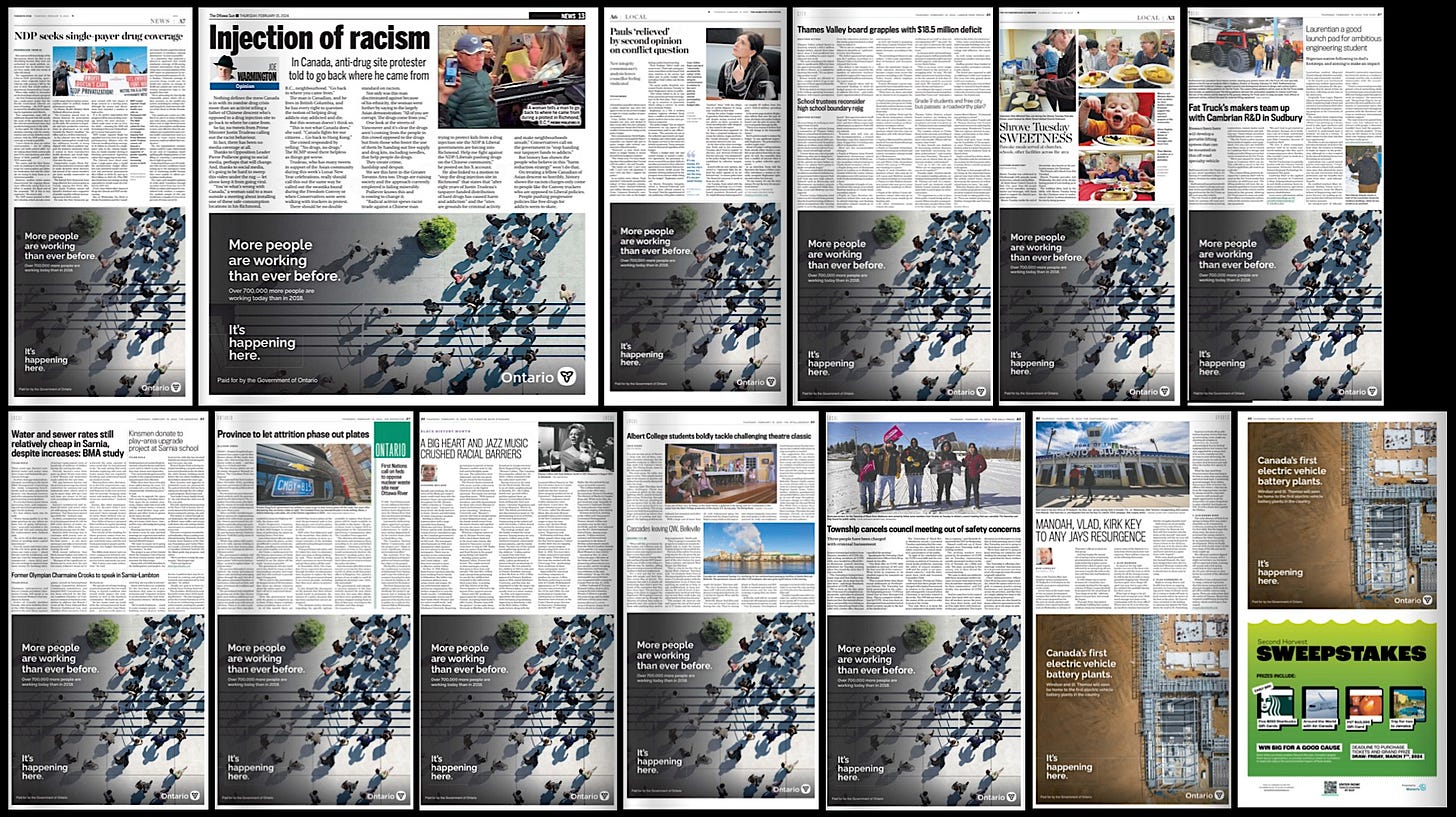It’s happening here, again
Ontario Government advertising follows the rules yet crosses the line into partisanship
These two ads, paid for by the taxpayers of Ontario, present an intriguing contrast. The one on the left, currently appearing in the Wall Street Journal, is government advertising. The one on the right is part of a multimedia campaign in Ontario. Both comply with the standards of the Government Advertising Act, as amended in 2016.
Under Section 1.1 of the Act, a government office may opt to communicate with the public to “promote Ontario or any part of Ontario as a good place to live, work, invest, study, or visit.” Both ads fit this description.
Most Ontario Government advertising must also undergo review by the Office of the Auditor General to ensure compliance with certain standards. A key criterion is the absence of partisanship. But what exactly qualifies as 'partisan' in ads that promote Ontario as an ideal place to live?
An advertisement is deemed partisan if it features the name, voice, or image of a member of the Executive Council or Assembly, except if the primary target audience is outside Ontario (e.g., a photo of Doug Ford in an ad in the WSJ). It’s also partisan if it includes a recognized party's name or logo, directly criticizes a recognized party or Assembly member, or significantly incorporates a colour associated with the governing party. Recall how Kathleen Wynne’s government faced accusations of favouring red autumn leaves and bricks in ads promoting government programs.
Let's be frank. Do Ontario residents – or voters, depending on the true intended audience – really need to be reminded that employment rates are high?
Isn't this a partisan message, crafted to cultivate a favourable view of the government?
It certainly appears so, and I anticipate the Auditor General will concur in its year-end report, as it did last year.
However, this concern became moot in 2015 when the Liberal government altered the rules. Before this change, ads fostering a positive government image were banned as partisan.
When in opposition, the Progressive Conservatives opposed this change and vowed to revert to the original rule during the 2018 election. In 2019, the NDP unsuccessfully attempted to restore the Auditor General’s authority to veto commercials deemed politically partisan.
Yet, these changes have not been implemented, and the current government hasn't hesitated to use partisan advertising to highlight its achievements. The Auditor General's 2023 report revealed that the government had spent about $25 million – nearly three-quarters of its total advertising budget – on ads it deemed partisan.
In an email to CBC News, Doug Ford’s director of media relations praised the campaign as “designed to instill pride in the many accomplishments of Team Ontario and confidence in the province's economy, especially during global economic uncertainty.”
Pride and confidence in Team Ontario?
The television spot, while conforming to current regulations, could easily be modified for the next provincial election with just the addition of the party logo. Is it necessary to purchase airtime during the Grammy Awards to foster pride and confidence? Proud of a place where 'it’s all happening'? And the revelation that we already live in that place?
Other than instilling pride in the many accomplishments of Team Ontario, there’s an upside to this massive ad spending on feel-good ads: it’s funnelling much-needed advertising revenue to newspapers and other media across the province. On Feb 15th, the ad appeared in papers across the province, from the North Bay Nugget to The Chatham Daily News.
Note how the folks living in the Windsor area were served a different ad, telling them that they already live in a place where there will soon be one of the two first electric vehicle battery plants in the country. A geotargeted ad they will likely recall during the next provincial election.
The most effective way to build pride and confidence in politicians would be to restore the Auditor General's authority to veto campaigns like these.






